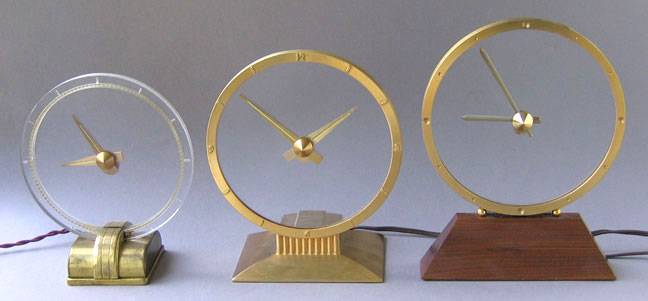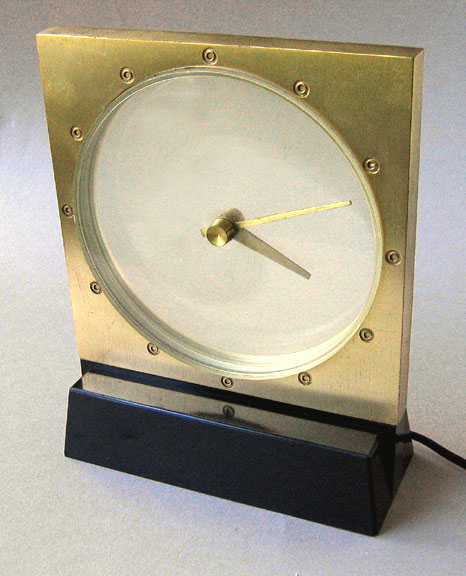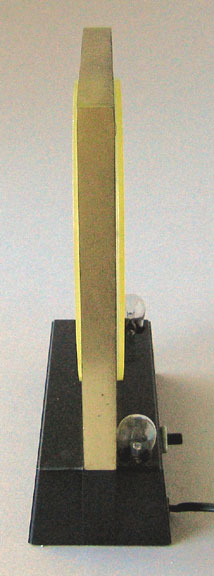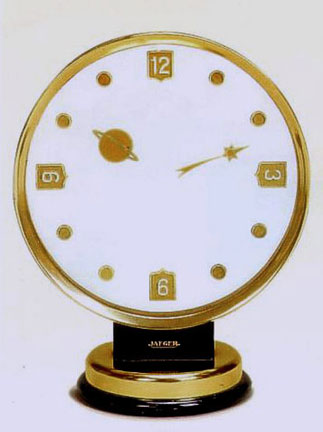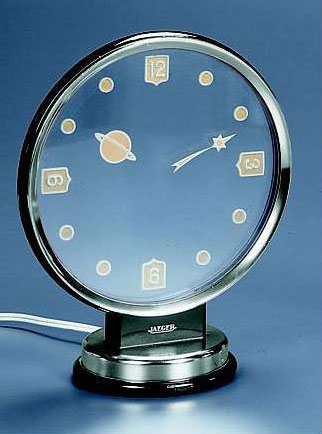The Clocks of Leendert
Prins
by Roger Russell
These
pages are copyrighted
No portion of this site may be reproduced in whole or in part
without written permission of the author.
What Is On this Page?
|
The Dutch
Secret |
|
|
||||
|
The Dutch Secret |
The Golden Hour |
|
The Magic Crystal |
|
The history begins with the three clocks shown above and are all based on the work of Leendert Prins. They are the Dutch Secret (left) made by Nederlandsche Uurwerkfabrieken (NUFA), the Golden Hour (Center) made by Jefferson Electric and the Magic Crystal (right) made by Etalage. These clocks, including several Jefferson Electric clocks, are based on patents awarded in the 1940's to Leendert Prins. The patents are No., RE22640, and No. 2,642,713. These patemts were incorporated into other designs as well and were sold under different names such as Etalage, Etalage Reclame,, Rex Cole and so on.
Jefferson had purchased the rights for patent number 2,248,195 from Prins, who received royalties of 3.5 percent from the sale of each clock that used his patented system. Although this patent describes the Magic Crystal, the design was modified by Jefferson but the principle of operation remained the same. See my Golden Hour page for a more detailed description. Despite the fact that the Dutch Secret had an internal lamp that illuminated the plastic outer ring, none of the Jefferson clocks were illuminated. The Dutch Secret and some early Jefferson clocks did have radium paint in the center of the hands and/or the dial ring.
Although Prins was from the Netherlands, he lived in New York City for many years but later returned to his home in the Netherlands. Leendert Prins died in 1978 but was survived by a son, Leo Jan Prins and Daughter Eleonora (Nora) Prins.
![]()
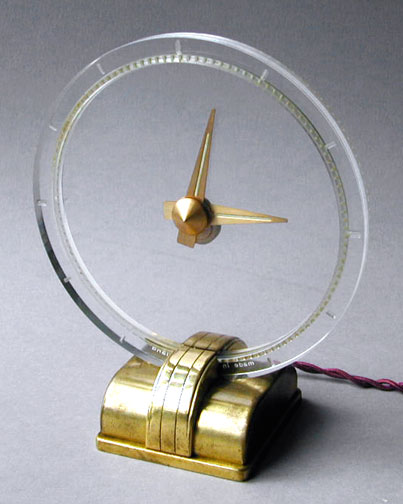
Pictures
and descriptions of this clock are from my article published in the
NAWCC Bulletin (National Association of Watch and Clock Collectors) October
2004 Page 600 [6 pages]
This was the first clock designed by Prins. It was made by NUFA in Amsterdam, Netherlands. Prins sold them as presentation gifts. The clock in the above picture was made to work with the European standard of 240 volts 50Hz.
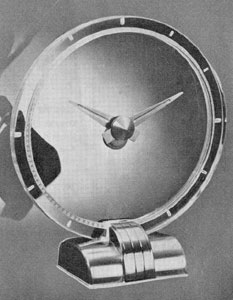 A catalog advertisement is shown at the left. The ad,
which was originally in Dutch, translates to read as follows: "Invisible
propulsion by a self-starting synchronous motor (220-240 Volt, 50 periods, 3
watt). The gilded hands are placed on a transparent plastic dial. A lamp fitted
in the base illuminates the hour indicators. Height 21 cm, Dial 17 cm."
The clock sold for 81 guilders or about $40.00.
A catalog advertisement is shown at the left. The ad,
which was originally in Dutch, translates to read as follows: "Invisible
propulsion by a self-starting synchronous motor (220-240 Volt, 50 periods, 3
watt). The gilded hands are placed on a transparent plastic dial. A lamp fitted
in the base illuminates the hour indicators. Height 21 cm, Dial 17 cm."
The clock sold for 81 guilders or about $40.00.
It appears to be made of brass and transparent Plexiglas. The outer ring is 6-7/8" in diameter and 7/16" thick. It has oval hour positions that have an indented frosted surface. The marks at 3, 6, 9, and 12 o'clock are 0.130" X 0.255" and are 0.070" deep. The other hours are 0.080" X 0.215" wide and are 0.045" deep. A unique feature is the use of a small light hidden in the base. When the clock is plugged in, the ring illuminates and the hour marks can be clearly seen in dim light. There is no switch to turn the light on or off. Each hand has a line of radium paint along the center that had glowed even if the light did not work. The words “Made in Holland” are at the bottom of the ring. Weight of the clock is 550 grams or about 1.2 lbs.
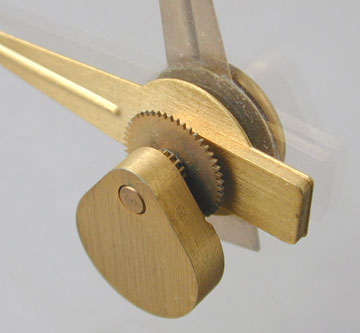 The picture at the right shows the hand assembly from
the back of the clock. The minute hand is mounted on the front of the plastic
disc. It is held by friction and can be moved to set the correct minutes. It is
2-13/16" long and 3/8" wide at the base. The hour hand and gear
assembly are located behind the disc. The hour hand is 2-1/2" long and
3/8" wide at the base.
The picture at the right shows the hand assembly from
the back of the clock. The minute hand is mounted on the front of the plastic
disc. It is held by friction and can be moved to set the correct minutes. It is
2-13/16" long and 3/8" wide at the base. The hour hand and gear
assembly are located behind the disc. The hour hand is 2-1/2" long and
3/8" wide at the base.
A shaft attached to the center of the disc has gears connected to the counterweight and hour hand. The gears reduce rotation so that one revolution of the disc advances the hour hand by one hour. The hour hand assembly can turn freely. The counterweight always stays in a vertical position and provides a fixed position needed to drive other gears that advance the hour hand. A small counterweight of metal is attached to the rear portion of the hour hand. It is the same shape and can be seen behind the main counterweight near the bottom of the picture. It serves to hold the hour hand in proper position relative to the minute hand.
The correct hours can be set by rotating the entire assembly one revolution in either direction for each hour. An indented line along the length of both hands contains radium paint. This is radioactive material. Although it may only glow faintly or not at all today, the radium is still active with a half life of 1600 years. Exposure to light was not necessary. The radiation intensity at one foot averages 0.03 mR/hr and is harmless. Even up close, at the point of contact, the combined radiation from both hands is only 2.1 mR/hr. Radium paint is no longer used in making watches and clocks.
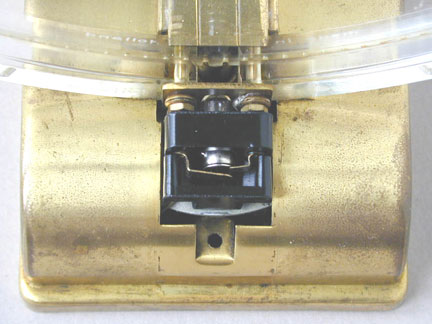 The base is 1-13/16" high, 3-1/4" wide and
3-1/2" deep. The top of the base has removable covers at the front and
rear. The front center cover has been removed in picture at the left by
removing a screw underneath the base. Access can then be gained to the Bakelite
lamp module. The module can then be unplugged from the base to replace the
lamp.
The base is 1-13/16" high, 3-1/4" wide and
3-1/2" deep. The top of the base has removable covers at the front and
rear. The front center cover has been removed in picture at the left by
removing a screw underneath the base. Access can then be gained to the Bakelite
lamp module. The module can then be unplugged from the base to replace the
lamp.
The filament of the incandescent lamp is positioned under the plastic dial ring. The two contact arms for the base of the lamp can be seen in the picture. The lamp is about the size of a T 1-3/4 bulb. It is a #6828 6 Volt 0.6 watt lamp and is no longer listed in the catalogs. It mounts similarly to a bayonet-style base and can be removed with a slight twist. The module plugs into the two brass pins on the main clock body. The pins are actually the ends of the screws that hold the plastic outer ring to the base of the clock. They also provide a power connection for the lamp.
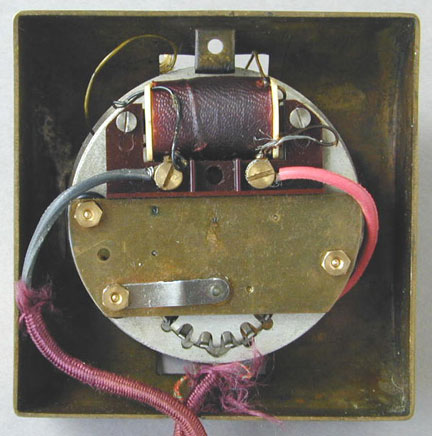
The two screws that hold the two base top covers also hold the bottom cover in place. When the bottom cover is removed, the motor and wiring are exposed as shown in the above picture. The motor assembly is welded to the base. Although reduction gears can be seen between the circular motor mounting plate and the upper part of the base, I made no attempt to take this apart.
What is most interesting about this arrangement is where the 6 volts comes from because the line voltage is 220 to 240 volts. There is a separate winding on the motor coil to provide this voltage and the winding is electrically isolated from the rest of the motor winding. The red and black wires are from the power line. The two small black wires go to the motor coil and two smaller wires go to the lamp module socket. Of course, a separate lamp winding was easily added in manufacture to the older motor coil but is not possible in more modern clock motor designs.
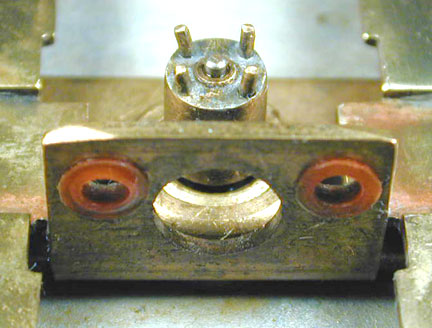 The plastic dial ring is held in place with the two
brass screws mentioned earlier. Two red insulating shoulder washers can be seen
where the two screws pass through.
The plastic dial ring is held in place with the two
brass screws mentioned earlier. Two red insulating shoulder washers can be seen
where the two screws pass through.
In the center of the left picture, the output gear from the motor can be seen. This is a brass cylinder that has four prongs that rotate. They mesh with the slots in the plastic disc holding the hands. There are 120 slots around the perimeter of the disc. The cylinder rotates at 30 revolutions per hour or 1/2 revolution per minute and this advances the disc one revolution per hour.
Although there is no date on the clock, there are several characteristics about it that indicate it is old and may have been made in the 1940's. The line cord is made of two insulated cloth-covered wires twisted together like much of the electrical equipment made in the 1920's and 1930's, such as Jefferson Electric toy transformers as well as toasters, lamps, etc. The disc and ring could be made of Plexiglas that was commonly available at that time. Plexiglas was introduced in 1936 by Rohm & Haas in both the United States and Germany. It was used extensively in airplanes in WWII as was radium paint for instrument knobs and dials. The motor is typical of older electric clocks of the 1940's, such as the Rex Cole clock describe further on.
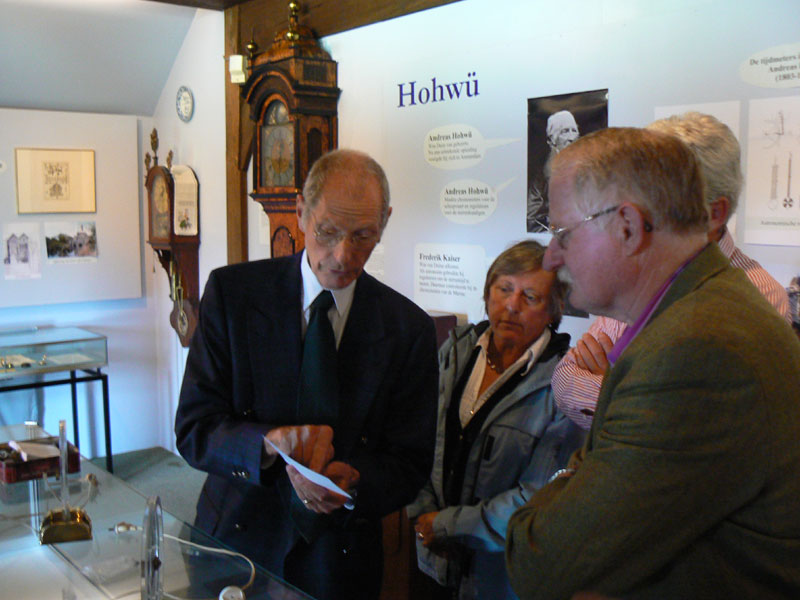
In June 2011, I received an email and pictures from Carel Hofland, Director of the Dutch Watch and Clock Museum. He was presented with a NUFA Dutch Secret clock from Mr. Arnoud Carp, a son of the former director of NUFA. This was a very welcome addition to the museum. Mr. Carp is in the front, his wife and the restorer, Jan Pool, is in the center.
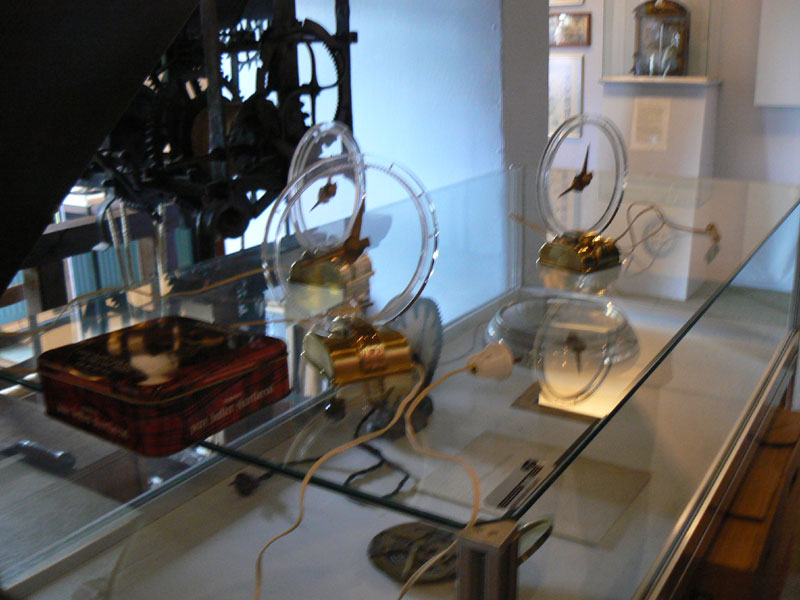
Here is a picture of the three clocks on the museum showcase. Only one of the clocks was donated to the museum. The other two remain in private hands. Now, including my own and one in Australia, there are five known Dutch Secrets. I gave Carel permission to use some of my pictures for his June digital publication.
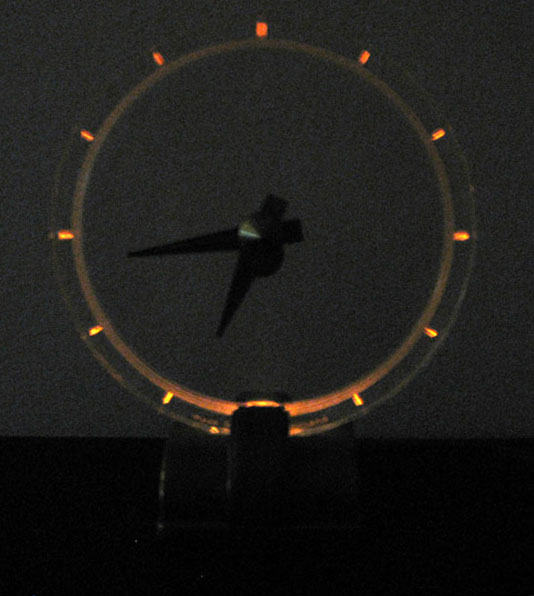
I was very pleased to hear from the owner of a Dutch Secret in New South Wales, Australia. Many thanks are given to Janey for these pictures of her clock being illuminated by the light in the base. Australia has the same 230 volt 50 Hz mains as Holland compared to 120 volts 60 Hz in the USA. The above view is from the front of the clock. The incandescent lamp illuminates the clear plastic outer ring that has engraved frosted numerals to indicate the hours and they reflect the light transmitted through the plastic. In addition, the lines on the hands have radium paint.
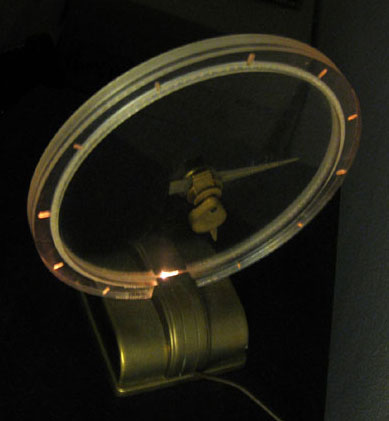
Here is the view from the rear of the clock. The base light shows a little more from this angle. When the clock was new, the radium paint on the hands may have also been visible in this subdued light.
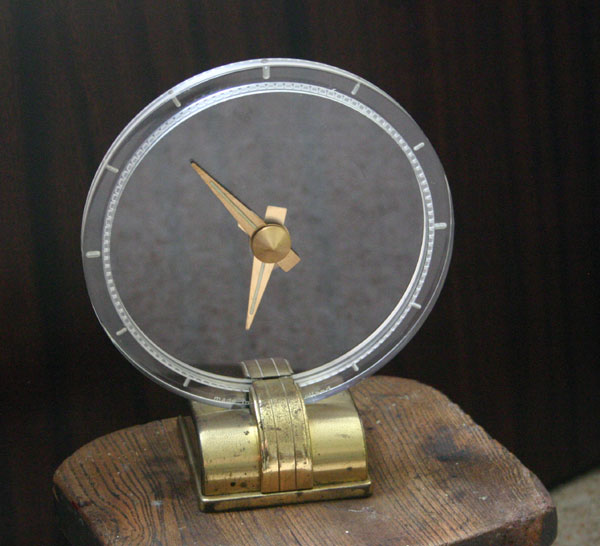
Dutch Secret number 6 has now been discovered in a
loft in Hampshire, UK.
Thanks to Charlie for the update and picture.
![]()
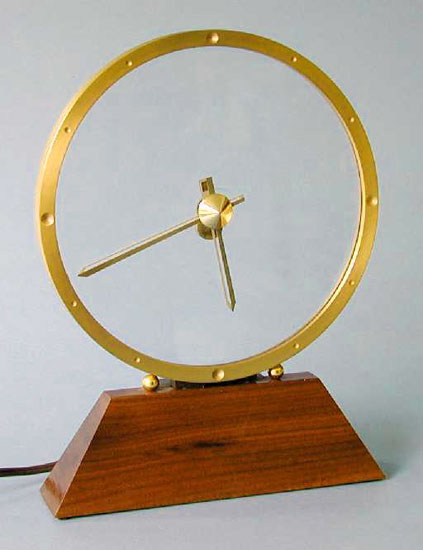
Pictures
and descriptions of this clock are from my article published in the
NAWCC Bulletin (National Association of Watch and Clock Collectors)
“Etalage and Rex Cole Mystery Clocks” October 2002
Page 571 [6 pages]
 There is no model number or name indicated on this
clock. However, an advertisement refers to the clock as the Magic Crystal
Clock. A picture from the ad is shown at the right.
There is no model number or name indicated on this
clock. However, an advertisement refers to the clock as the Magic Crystal
Clock. A picture from the ad is shown at the right.
 The nameplate on the bottom says Etalage-Reclame
Corporation, 48 East 28th Street, New York City. Etalage
and Reclame are French words that mean something like
dramatically-effective display. Prins and his
daughter Nora, shown in the picture at the right, lived in New York where she
spent hundreds, perhaps thousands of hours assembling these and the earlier Etalage MagiClocks at their New
York address. They returned to Holland in the 1950’s.
The nameplate on the bottom says Etalage-Reclame
Corporation, 48 East 28th Street, New York City. Etalage
and Reclame are French words that mean something like
dramatically-effective display. Prins and his
daughter Nora, shown in the picture at the right, lived in New York where she
spent hundreds, perhaps thousands of hours assembling these and the earlier Etalage MagiClocks at their New
York address. They returned to Holland in the 1950’s.
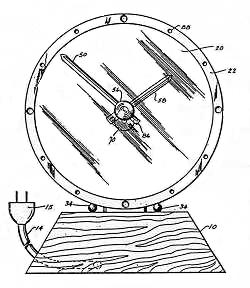 The clock could be thought of as an improved version
of earlier designs and a closer similarity to the first Jefferson clock. A
patent number RE 22640 is stamped in ink on the bottom of the wood base. This
is a reissue of patent number 2,248,195 on May 1, 1945. Application number
645,998 was filed on February 7, 1946 but it was abandoned. Application for a
new patent, serial number 101,510, was made in France on September 10, 1948 and
in the United States on June 27, 1949. On June 23, 1953 the patent number
2,642,713 was issued to Leendert Prins.
After Jefferson bought the patent, this number appears on several clocks such
as the Golden Hour, Golden Minute and Golden Helm clocks. The patent describes
the clock in great detail with 3 pages of illustrations. The round dial, glass
and hand assembly is mounted on a wooden base. The motor is mounted vertically
and protrudes from the rear of the clock. A sketch from the patent is shown at
the left.
The clock could be thought of as an improved version
of earlier designs and a closer similarity to the first Jefferson clock. A
patent number RE 22640 is stamped in ink on the bottom of the wood base. This
is a reissue of patent number 2,248,195 on May 1, 1945. Application number
645,998 was filed on February 7, 1946 but it was abandoned. Application for a
new patent, serial number 101,510, was made in France on September 10, 1948 and
in the United States on June 27, 1949. On June 23, 1953 the patent number
2,642,713 was issued to Leendert Prins.
After Jefferson bought the patent, this number appears on several clocks such
as the Golden Hour, Golden Minute and Golden Helm clocks. The patent describes
the clock in great detail with 3 pages of illustrations. The round dial, glass
and hand assembly is mounted on a wooden base. The motor is mounted vertically
and protrudes from the rear of the clock. A sketch from the patent is shown at
the left.
The clock is 9-7/8" high, 9-1/2" wide and 2-1/4" deep. Weight is 2 lbs. The lacquered solid walnut base is 7-1/2" wide, 2-1/4" high and 1-3/4" deep. The front and back of the wood is angled in at about 15 degrees. The sides are angled at 60 degrees. There are four 1/4" diameter brown felt pads on the bottom in the corners. The outer ring appears to be gold plated. It has rounded depressions about 1/16" deep and 1/4" in diameter to indicate the hours of 3, 6, 9 and 12 o'clock. The remaining hours have rounded depressions about 1/32" deep and 1/8" in diameter. A retaining ring holds the glass disk in the frame. Three small lugs are equally spaced around the rear of the frame. The retaining ring may be resiliently snapped into position to hold the disk.
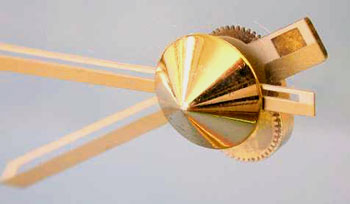 The clock incorporates a single transparent disc. The
minute hand is held to the front of the glass by spring washers and a cone nut.
It is held by friction so that it can be easily turned to set to the desired minutes.
The hour hand and gear assembly are located behind the glass. A shaft passes
through the center of the glass to the hour hand assembly.
The clock incorporates a single transparent disc. The
minute hand is held to the front of the glass by spring washers and a cone nut.
It is held by friction so that it can be easily turned to set to the desired minutes.
The hour hand and gear assembly are located behind the glass. A shaft passes
through the center of the glass to the hour hand assembly.
The rest of the assembly is located behind the glass. The shaft attached to the center of the disc has gears connected to the counterweight and hour hand. The gears reduce rotation so that one revolution of the disc advances the hour hand by one hour. The hour hand assembly can turn freely. The pear-shaped counterweight always stays in a vertical position and provides a fixed position needed to drive other gears that advance the hour hand.
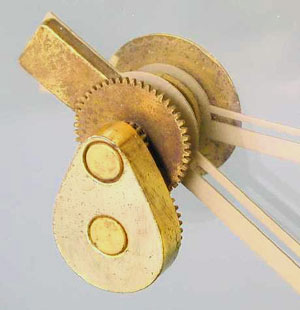 The picture at the right shows the rear of the hands
and counterweight assembly. There's also a counterweight at the end of the hour
hand and can be seen near the top left of the picture. It serves to hold the
hour hand in proper position relative to the minute hand. The hour and minute
hands are about 3/16" wide. They have a slot about .038" wide for
most of their length. The wide portion is gold colored and the thinner portion
is light beige. The back of the hands is also light beige. Radium paint is not
used on this clock and there is no illumination.
The picture at the right shows the rear of the hands
and counterweight assembly. There's also a counterweight at the end of the hour
hand and can be seen near the top left of the picture. It serves to hold the
hour hand in proper position relative to the minute hand. The hour and minute
hands are about 3/16" wide. They have a slot about .038" wide for
most of their length. The wide portion is gold colored and the thinner portion
is light beige. The back of the hands is also light beige. Radium paint is not
used on this clock and there is no illumination.
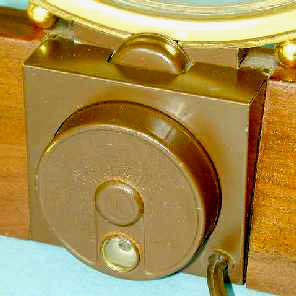 The clock is powered by a synchronous motor made by
Haydon Mfg. Co, Torrington, Conn. It's rated at 110V--60C and 2.3W. The output
gear is 1 RPM. A 60:1 reduction results in the clock face turning at the
required 1/60 rpm, or one revolution per hour. The motor is mounted in a metal
housing 2-1/2" wide and 2-1/4" high that extends into the wooden
base. The assembly is painted dark brown. The numbers 8/48 on the motor
indicate that the motor was made in August of 1948 and the clock may have also
been made in 1948. A second clock has been found with a motor date of 12/49.
The clock is powered by a synchronous motor made by
Haydon Mfg. Co, Torrington, Conn. It's rated at 110V--60C and 2.3W. The output
gear is 1 RPM. A 60:1 reduction results in the clock face turning at the
required 1/60 rpm, or one revolution per hour. The motor is mounted in a metal
housing 2-1/2" wide and 2-1/4" high that extends into the wooden
base. The assembly is painted dark brown. The numbers 8/48 on the motor
indicate that the motor was made in August of 1948 and the clock may have also
been made in 1948. A second clock has been found with a motor date of 12/49.
The Magic Crystal clock does tend to be a little tipsy as most of the weight is at the top and the base is not deep enough to keep it steady. In comparison, the Jefferson Golden Hour is very stable and has no tendency to tip over.
One clock I have seen had an embossed label pasted on the bottom. Although the front part of the label had been peeled off the embossing could still be read. It says Tourneau, Importers of Watches, Madison Avenue, New York. This may have been the dealer that originally sold the clock back in the late 1940's.
On the Inside
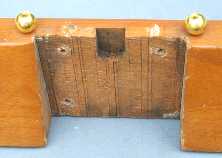 The square metal housing around the motor is made of
steel. It is held in place by four metal tabs. These must be bent in order to
get the housing off. In one clock I have seen the tabs broken off, probably
from repeated bending. The motor is mounted on a metal casting and is attached
to the base with three wood screws. The indent in the wood in the center is
where an intermediate gear fits. When the wood screws are removed the motor,
casting and ring assembly can be removed from the base.
The square metal housing around the motor is made of
steel. It is held in place by four metal tabs. These must be bent in order to
get the housing off. In one clock I have seen the tabs broken off, probably
from repeated bending. The motor is mounted on a metal casting and is attached
to the base with three wood screws. The indent in the wood in the center is
where an intermediate gear fits. When the wood screws are removed the motor,
casting and ring assembly can be removed from the base.
 The two decorative brass balls are held with two
threaded pieces that have been inserted into the wood base. This is all in
accordance with the patent description. The two flat head machine screws that
hold the casting to the outer ring can be seen in the picture below and to the
right. The view is from the front of the clock.
The two decorative brass balls are held with two
threaded pieces that have been inserted into the wood base. This is all in
accordance with the patent description. The two flat head machine screws that
hold the casting to the outer ring can be seen in the picture below and to the
right. The view is from the front of the clock.
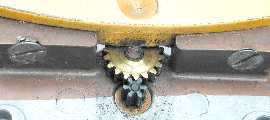 The motor output gear has 6 teeth and runs at 1 RPM.
It meshes with a brass intermediate gear that has 18 teeth and this makes a
gear reduction of 3 to 1.
The motor output gear has 6 teeth and runs at 1 RPM.
It meshes with a brass intermediate gear that has 18 teeth and this makes a
gear reduction of 3 to 1.
The intermediate gear meshes with the outer ring gear that has 360 teeth. This is a reduction of 20 to 1. The total reduction is 60 to 1 and the outer gear rotates at the required one revolution per hour.
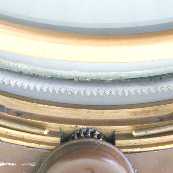 The picture at the left shows some of the parts of the
dial ring assembly spread apart. This view is from the rear. It consists of a
gold colored rear cover shown at the top. The rear cover is held in place by 3
small tabs that are part of the ring casting. Behind and below it is the outer
gear ring with the glass that is glued to it. The teeth of the outer ring are
triangular much like a saw blade. The ring is made of steel. Below that is the
cast ring showing several steps. The intermediate brass gear can just be seen
above the motor gearbox at the bottom of the picture.
The picture at the left shows some of the parts of the
dial ring assembly spread apart. This view is from the rear. It consists of a
gold colored rear cover shown at the top. The rear cover is held in place by 3
small tabs that are part of the ring casting. Behind and below it is the outer
gear ring with the glass that is glued to it. The teeth of the outer ring are
triangular much like a saw blade. The ring is made of steel. Below that is the
cast ring showing several steps. The intermediate brass gear can just be seen
above the motor gearbox at the bottom of the picture.
On either side of the intermediate gear, the ends of a circular split retainer ring can be seen. This circular retainer is shown the way it fits in one of the steps. It's made of brass wire that's 0.073" in diameter. It goes between the outer gear ring and the cover and serves to keep the outer gear ring and glass assembly in place.
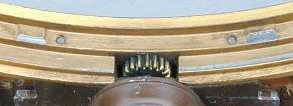 In the picture at the right, two raised areas are on
the inside of the ring. This is where the weight of the glass/hand assembly
rests. The assembly weighs 191 grams or about 6.7 ounces. The wear is not equal
for the two tabs indicating that the retainer ring is probably not centering
the gear ring from front to back as well as it should have.
In the picture at the right, two raised areas are on
the inside of the ring. This is where the weight of the glass/hand assembly
rests. The assembly weighs 191 grams or about 6.7 ounces. The wear is not equal
for the two tabs indicating that the retainer ring is probably not centering
the gear ring from front to back as well as it should have.
![]()
|
|
|
Here is another clock from the Prinz collection. It is labeled Sonic Industries, Inc., New York 13, NY. The model 146 is an unlighted version The model 246 is identical but has two lamps.
The mystery here is that there appears to be no obvious way to make the hands move. Unlike the Magic Crystal, there's no counterweight or gears to drive the hour hand from the minute hand.
The face consists of two transparent plastic discs 5-15/16" diameter. They are concave shaped as seen from the outside. The front disc has the minute hand attached by friction and a 3/8" diameter knob at the center that can be used to set the minutes. The rear disc has the hour hand attached in a similar way and with a similar knob to adjust the hours. The knobs don't show in the side view because they are in the center of the concave discs.
The dial frame and back is made of a cast brass with a satin gold finish. There are 12 countersunk circles 1/4" in diameter to indicate the hours. The back plate is held in place by four screws in the corners. The black base containing the motor is Bakelite. Three patent numbers are indicated on the label. They are 2,248,195, 2,201,376 and 1,855,648. These were awarded to Leendert Prins and are described in my Jefferson Electric History page.
On a shipping box it says "The Mystery Electric Clock, Etalage, MagiClock, Daton Corp. New York 11, N.Y." The motor is made by Haydon and rated at 1/2 RPM. Power requirements are 115V 60C 2.5W. The clock is 8-1/2" high, 6-3/4" wide and 2-3/4" deep. The base height is 1-3/4". It is UL approved. Weight is 2.0 lbs.
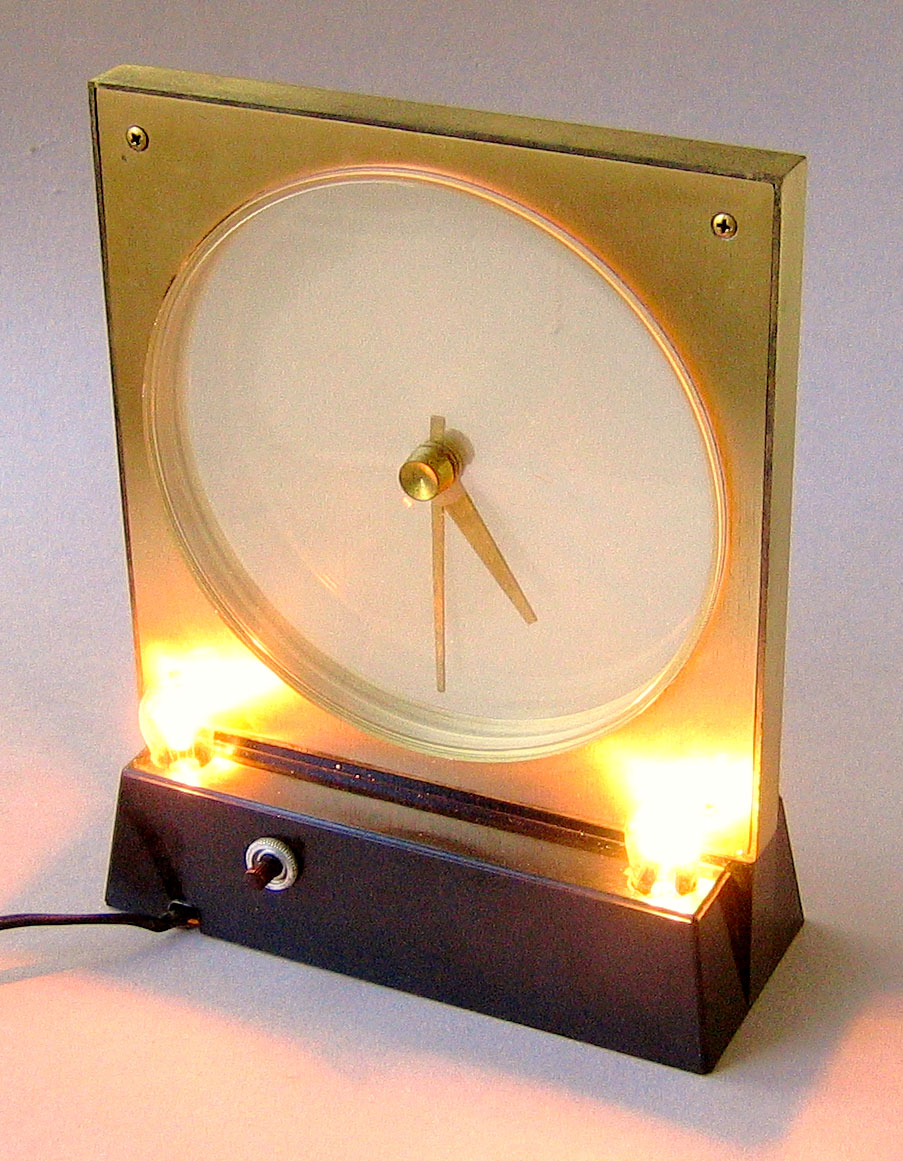
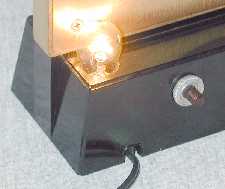 The model 246 has two lights mounted in the rear of
the base. The tops of the bare bulbs stick up from sockets mounted inside the
base. There's a switch at the left side in the back of the base to turn the
lights on and off. When seen from the front, light reflected from any surface behind
it will make the hands visible at night and it also makes a nice night light.
The model 246 has two lights mounted in the rear of
the base. The tops of the bare bulbs stick up from sockets mounted inside the
base. There's a switch at the left side in the back of the base to turn the
lights on and off. When seen from the front, light reflected from any surface behind
it will make the hands visible at night and it also makes a nice night light.
The two lamps are wired in parallel. The lamps are type S-6 and have a candelabra base. They are rated at 6 watts and can still be found at electrical supply stores.
On the Inside
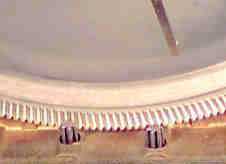 Two 6 tooth gears come through the base to drive the
separate plastic discs. One is near the front and the other is near the rear.
The gears turn at different speeds for the hour and minute hand. Each plastic
disc has 300 cogs that engage the respective gear. The minute hand can be seen
at the right in the gear photo. One disc has been removed to show the gears.
The cogs in the plastic discs show no sign of wear in any of the clocks I have
seen.
Two 6 tooth gears come through the base to drive the
separate plastic discs. One is near the front and the other is near the rear.
The gears turn at different speeds for the hour and minute hand. Each plastic
disc has 300 cogs that engage the respective gear. The minute hand can be seen
at the right in the gear photo. One disc has been removed to show the gears.
The cogs in the plastic discs show no sign of wear in any of the clocks I have
seen.
A 4" leaf type spring is attached to the front plate In the picture it's located just behind the two gears at the bottom. The spring pushes the disc against the closest gear so it makes good contact. The right side of the spring is glued to the front frame and the left side is free to slide when the disc is installed. A similar spring is glued to the back plate and pushes the rear disc against the other gear. I have seen five of these clocks and only two of them still have the springs. The others were apparently lost. The clocks don't work very well without them.
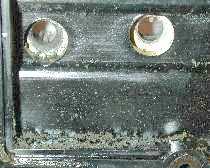 Because the springs have pushed the 6-tooth gears over
the years there has been an unusual amount of wear both in the brass gears and
the holes in the Bakelite base where the gears pass through. An accumulation of
Bakelite powder can be seen at the bottom of the picture that has worn from the
left hole in the base. Later versions avoided wear on the brass gears by using
steel instead. However, the plastic still gets worn.
Because the springs have pushed the 6-tooth gears over
the years there has been an unusual amount of wear both in the brass gears and
the holes in the Bakelite base where the gears pass through. An accumulation of
Bakelite powder can be seen at the bottom of the picture that has worn from the
left hole in the base. Later versions avoided wear on the brass gears by using
steel instead. However, the plastic still gets worn.
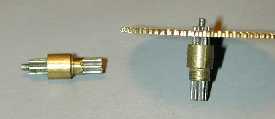 The motor is mounted on a metal plate and drives the
smaller minute gear. The other end drives the minute disc. This gear also
drives the large gear. The other end of the large gear drives the hour disc.
The center portion of the large gear is identical to the smaller gear. It is
force fitted into a hole in the large gear. I noticed it was soldered in place
as well in a couple of the clocks.
The motor is mounted on a metal plate and drives the
smaller minute gear. The other end drives the minute disc. This gear also
drives the large gear. The other end of the large gear drives the hour disc.
The center portion of the large gear is identical to the smaller gear. It is
force fitted into a hole in the large gear. I noticed it was soldered in place
as well in a couple of the clocks.
The brass gears had an additional problem. A small tip at the end of each gear fits into the metal plate that the motor is mounted on. In some clocks, these have worn off completely and of course the clocks no longer work properly. The steel tips have not been affected.
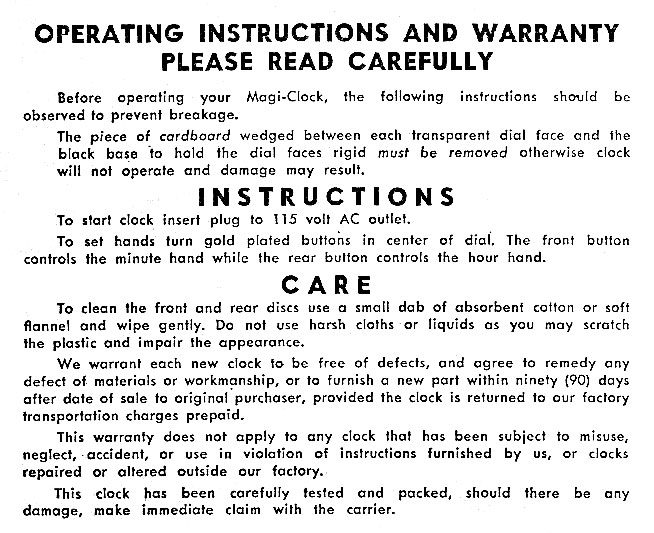
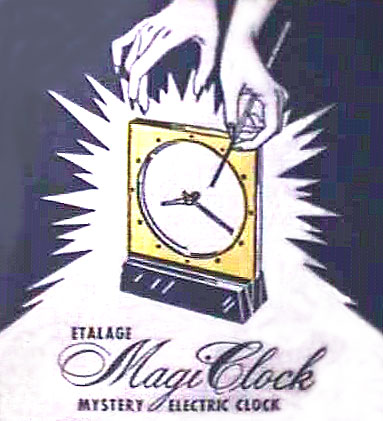
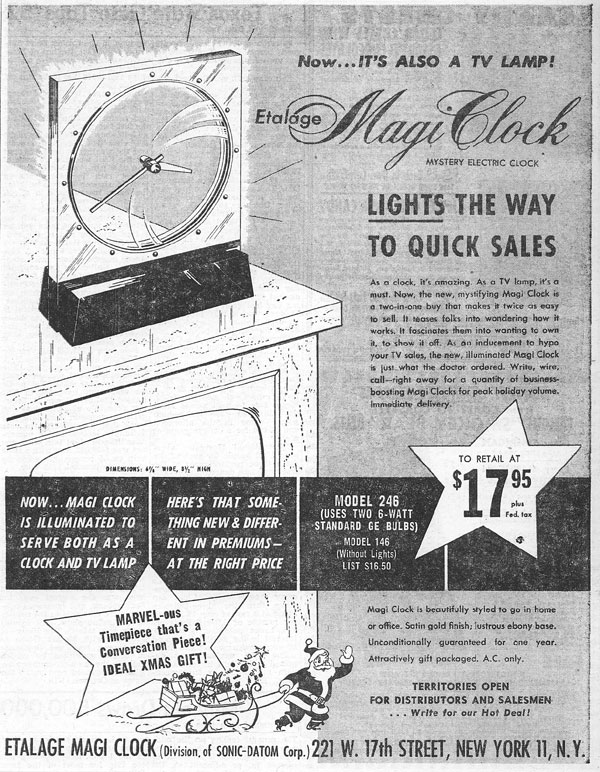
Advertisment from 1953.

Here is a recent picture from google at this location.
![]()
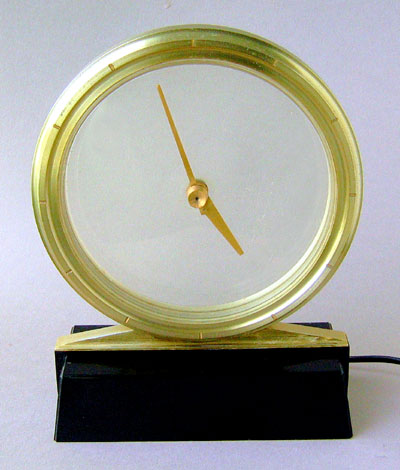
This clock is rarely found and is another version of the MagiClock. It has the same Bakelite base but is not lighted. The two plastic discs and drive mechanism are also the same as the square version.
![]()
Etalage Transparent Mystery Clock
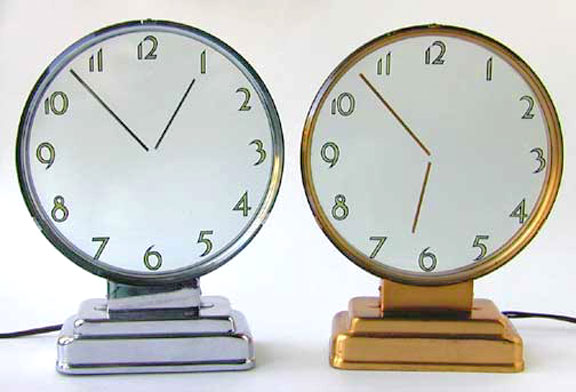
Pictures
and descriptions of this clock are from my article published in the
NAWCC Bulletin (National Association of Watch and Clock Collectors)
“Etalage and Rex Cole Mystery Clocks” October 2002
Page 571 [6 pages]
Here is yet another Prins design. This clock is similar to patent number 2,248,195. It was applied for on April 30, 1937 and issued on July 8, 1941. It was reissued May 1, 1945. Application for reissue was June 14, 1944 serial number 540,233. The patent describes a clock with two transparent rotating discs, one for the minute hand, and one for the hour hand. The geared perimeters are driven at different speeds from different gears in a gear train driven by a motor. The two discs are enclosed by front and back transparent discs. The clock differs from the patent in that the hour and minute discs are of equal diameter.
In the clocks pictured above, there are four glass discs. The front one has beveled edges and has the numbers painted on the back of the glass. The second disc has the minute hand glued to it. The minute hand is solid metal 3" long and 3/32" square. The Third disc has the hour hand glued to it. The hour hand is solid metal 2-1/8" long and 3/32" square. The rear disc is clear and has a beveled edge. It's there for protection. Three clamps hold the front and back discs in place. They are located at 12, 4 and 8 o'clock and each is attached to a cast metal outer ring with two screws. The numbers 10, 11 and 12 on the front glass are styled with the 1 being shorter. The clocks were sold with either a chrome or gold finish. The numerals are the same color in both clocks. They are yellow with a dark blue outline.
The steel base plate is force fitted into place inside the base. It has a green felt pad in each corner that is 3/4" in diameter. The plate is stamped with Etalage Reclame Corp., New York. AM patents 2,248,195, 2,201,376 and 1,855,648. There is no model name or number.
The clock is 9-5/8" high. The dial is 7-3/8" in diameter and 1-3/16" thick. The base at the bottom is 5-5/8" wide and 2-3/4" deep. It weighs 1750 grams or about 3.8 lbs. It comes with a 5-foot 5-inch brown line cord that has a small molded white plug on the end.
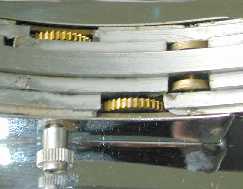 The outer ring contains all four pieces of glass.
Here's a picture of the bottom portion of the ring. The time set knob is at the
rear of the clock and can be seen at the bottom left side of the picture. The
two inner discs are 6-7/6" in diameter and are each glued to an outer gear
ring that has 360 teeth. The teeth of the outer ring are triangular much like a
saw blade. The rings are made of steel. Each disc and ring weighs 163 grams or
about 5.8 ounces. The outer beveled pieces of glass are 7-5/32" in diameter.
The outer ring contains all four pieces of glass.
Here's a picture of the bottom portion of the ring. The time set knob is at the
rear of the clock and can be seen at the bottom left side of the picture. The
two inner discs are 6-7/6" in diameter and are each glued to an outer gear
ring that has 360 teeth. The teeth of the outer ring are triangular much like a
saw blade. The rings are made of steel. Each disc and ring weighs 163 grams or
about 5.8 ounces. The outer beveled pieces of glass are 7-5/32" in diameter.
Much of the weight rests on two free turning brass wheels shown at the right of the gears. Each ring is shaped so that the teeth engage the brass drive gears that each have 36 teeth. This makes a gear reduction of 10 to 1. The front gear (at the top of the picture) turns the minute hand disc at one revolution per hour. The rear gear turns the hour hand.
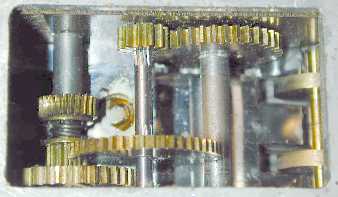 A Synchron motor is located
in the base and is made by the Hansen Mfg. Co., Inc,
Princeton, Indiana. It is model 600, 4 rpm, 110V, 60C. The gears in the picture
are located in the neck of the clock. The view is from the bottom with the
motor removed. These gears reduce the rotation of the motor shaft from 4 rpm
down to 1/6 rpm for the minute hand gear. They further reduce the rotation for
the hour hand gear to 1/72 rpm. Combined with the 10 to 1 reductions to the
minute and hour discs, this provides the required 1/60 rpm for minutes and
1/720 rpm for the hours.
A Synchron motor is located
in the base and is made by the Hansen Mfg. Co., Inc,
Princeton, Indiana. It is model 600, 4 rpm, 110V, 60C. The gears in the picture
are located in the neck of the clock. The view is from the bottom with the
motor removed. These gears reduce the rotation of the motor shaft from 4 rpm
down to 1/6 rpm for the minute hand gear. They further reduce the rotation for
the hour hand gear to 1/72 rpm. Combined with the 10 to 1 reductions to the
minute and hour discs, this provides the required 1/60 rpm for minutes and
1/720 rpm for the hours.
A worm gear on the shaft of the motor drives the upper left gear in the picture. A spring can be seen just below this gear. A smaller shaft for the time set knob goes through the spring to the 2-piece gear at the bottom left. The spring provides a friction clutch coupling from the motor to the 2-piece gear at the bottom left. The larger portion drives the minute hand disc. The smaller portion drives reduction gears to the hour hand. The hour drive gear is the large gear at the top of the picture. At the right of the picture are the two free turning brass wheels.
The set time knob can be turned in either direction. This will advance the minutes forward or backward. There is no separate advance for the hours and many turns may be needed to set the correct time.
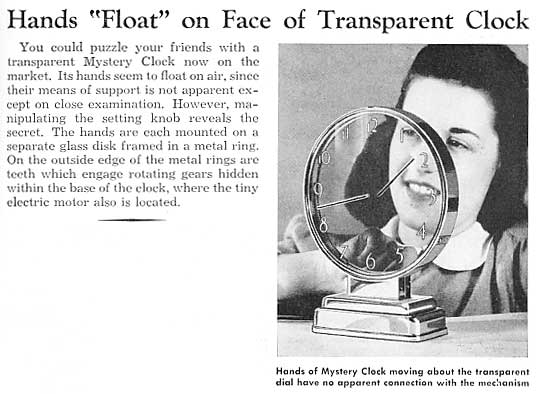
This
clock was shown in the June 1942 issue of Popular.
Mechanics, page 61. In the "Where-To-Buy-It Index" on page 4A, it is
titled
"Transparent Mystery Clock… Etalage Reclame Corp., 48 E. 28th St., New York City"
![]()
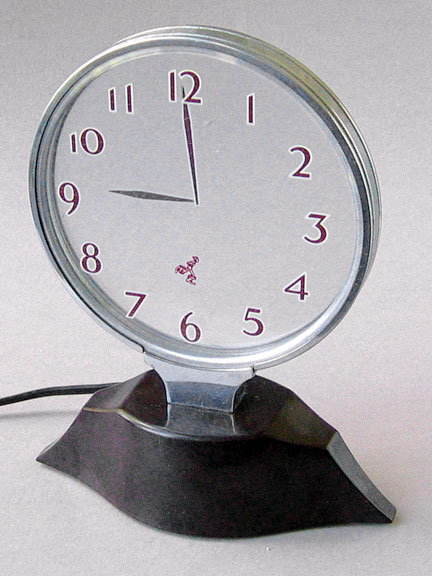
Pictures
and descriptions of this clock are from my article published in the
NAWCC Bulletin (National Association of Watch and Clock Collectors)
“Etalage and Rex Cole Mystery Clocks” October 2002
Page 571 [6 pages]
This Rex Cole model number 5-A is identical to the Boots Boy model 5-A. The only difference is the wording on the bottom plate. It has 4 glass discs enclosed with a metal hoop. The numerals are on the back of the front piece of glass. The minute hand is on the front of the second piece and the hour hand is on the third piece. The fourth, or rear piece, is for protection. A running "Boots Boy" figure is on the rear of the front glass just above the 6. The front and back discs are beveled for about 1/8" at the rim but are still held by the hoop. The two inside discs are free to turn.
The metal hoop appears to be chrome plated and is attached to a Y shaped post by two screws underneath. The rear of the post has a 1/2" knurled knob to set the time. The two screws in the picture hold the dial assembly to the base of the clock. To set the time, the knob can be turned in either direction. This will advance the minutes. There is no separate advance for the hours and many turns may be needed to set the correct time.
The base is a smooth brown wood grain Bakelite. It is 6" wide, 2-5/8" deep at the center and 1-5/8" high. The hoop is 5-3/16" in diameter. The overall height is 7-1/2" including the four rubber feet on the base. The clock weighs 640 grams or about 1.4 lbs.
The nameplate says "REX COLE Inc., Model 5-A Pat. No. RE 22640 others pending, 110V - 125V A.C. 60 cycles 2 watts serial 08000." The RE 22640 has three lines drawn through it. An earlier clock, serial 03145, does not have the three lines through it. Like the Etalage model described earlier, it follows the Prins patent number 2,248,195 that was reissued as RE22640 on May 1, 1945.
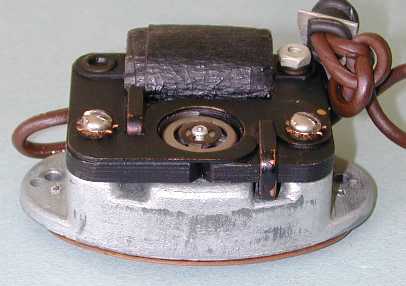 Although self-starting, the motor looks like an early
design. The wheel in the center is on the rotor shaft. The coil is in the rear.
The laminations are attached with two screws to the bottom casting, which may
be made of zinc alloy. The laminations are 2" wide and 1-5/8" deep
Although self-starting, the motor looks like an early
design. The wheel in the center is on the rotor shaft. The coil is in the rear.
The laminations are attached with two screws to the bottom casting, which may
be made of zinc alloy. The laminations are 2" wide and 1-5/8" deep
The output from the motor is a tiny 1/8" gear with 10 teeth. This drives a thin 5/8" gear having 60 teeth. The shaft of the 60-tooth gear goes through a metal plate into the Y shaped post.
The Boots Boy Emblem and Rex Cole
Why is there a Boots Boy figure? It may be that this clock was sold or used as a presentation for customers or salesmen and may have been made for Rex Cole by Prins or a sub-contractor. A book titled Rex Cole on Salesmanship by Rex Cole in collaboration with C. D. Frazer was published by B. C. Forbes Publishing Company, 120 Fifth Avenue, New York City in 1935 (253 pages). It's a guide on how to be a good salesman. "It is based principally upon the experience of Rex Cole and members of his organization." In the introduction it states:
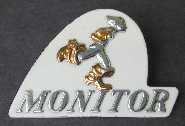 "On the hood of his car and at his farm, on the
chinaware, the table linen, the door mats, the flag pole and every other nearly
appropriate place, he has neatly affixed his emblem--The Seven League Boots
Boy. Remember the legend? The boy whose boots helped him step clear over all
obstacles, over depressions, from mountain to mountain, seven leagues at a
time--toward his objective. Here is a silent sermon for salesmen who falter
along on the ground and do not see high or far enough. This is
"On the hood of his car and at his farm, on the
chinaware, the table linen, the door mats, the flag pole and every other nearly
appropriate place, he has neatly affixed his emblem--The Seven League Boots
Boy. Remember the legend? The boy whose boots helped him step clear over all
obstacles, over depressions, from mountain to mountain, seven leagues at a
time--toward his objective. Here is a silent sermon for salesmen who falter
along on the ground and do not see high or far enough. This is 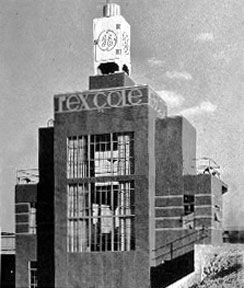 one of the first lessons: "Hitch your wagon to a
star"; or better still, as Justice Holmes suggested, steer your course by
a star that you have never seen." This emblem came from a washing machine
made by the Monitor Equipment Corporation. Monitor also made several different
AM radios in the 1940's. The name plate at the left came from a Monitor
Equipment Corporation washing machine that may also have been available from
Rex Cole.
one of the first lessons: "Hitch your wagon to a
star"; or better still, as Justice Holmes suggested, steer your course by
a star that you have never seen." This emblem came from a washing machine
made by the Monitor Equipment Corporation. Monitor also made several different
AM radios in the 1940's. The name plate at the left came from a Monitor
Equipment Corporation washing machine that may also have been available from
Rex Cole.
Rex Cole Inc. was the New York distributor for General Electric refrigerators. Remember the ones that had the cylindrical “beehive” compressor on the top? Starting in 1928, Raymond Hood designed four Rex Cole showroom buildings. They were all different but had a modernist approach typical of the period of "stylistic ferment." An article about the buildings was published in American Architect, December 1931. The buildings were located at 6528-6530 Fourth Ave., Bay Ridge, Brooklyn, 2392 Grand Concourse in The Bronx, 137-155 Northern Blvd in Flushing, Queens and at the gateway to the Ridge section of Brooklyn. One building had a very large GE symbol etched into the transparent glass so that at night, when lit from behind, the facade became a glowing advertisement. The building at the right had a large replica of the GE refrigerator at the top.
![]()
“Etalage and Rex Cole Mystery Clocks”
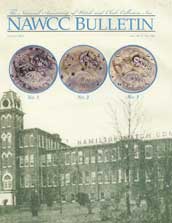
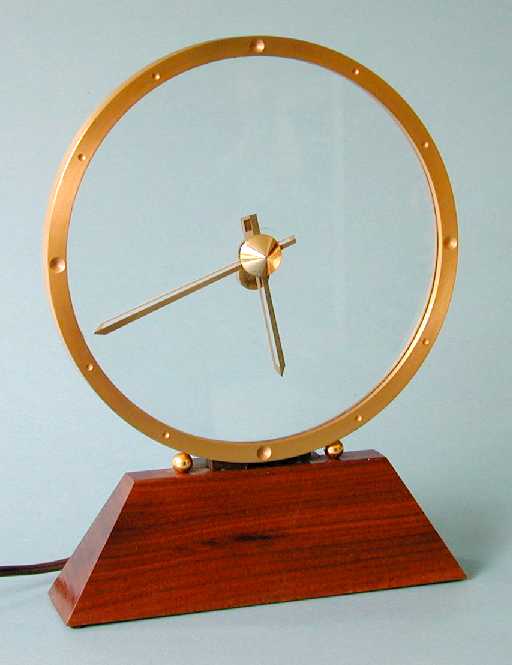 Written by Roger Russell and published in the NAWCC
Bulletin
Written by Roger Russell and published in the NAWCC
Bulletin
(National Association of Watch and Clock Collectors) October 2002 Page 571 [6
pages]
The mystery is how the hands are driven without any visible means. Several clocks made by Jefferson Electric have a patent number 2,642,713 on the clock. However, the clock described in the patent was made by Etalage Reclame Corporation of New York. The patent was awarded to Leendert Prins, Bilthoven, Netherlands, in 1953. Jefferson apparently bought the rights to the patent.
The Etalage Magiclock and Rex Cole mystery clocks are also described in this article. These were made based on earlier patents also awarded to Leendert Prins.
![]()
LeCoultre Mystery Clocks
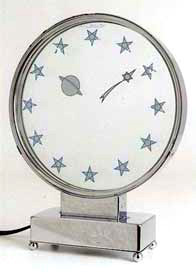 Signed by Jeager LeCoultre. Dated about 1940. Two inner glass discs rotate
driven by a motor and gears in the base. The hours are indicated by a planet
and minutes are indicated by a shooting star. A stationary front glass has
stars indicating the hours. The outer ring, base and ball feet are chrome
plated.
Signed by Jeager LeCoultre. Dated about 1940. Two inner glass discs rotate
driven by a motor and gears in the base. The hours are indicated by a planet
and minutes are indicated by a shooting star. A stationary front glass has
stars indicating the hours. The outer ring, base and ball feet are chrome
plated.
This clock is very similar to the Etalage transparent mystery clock described above and was apparently made about the same time. This design is also based on a patent awarded to Leendret prins.
It may have been made by Etalage for LeCoultre.
In addition, Jaeger LeCoultre also sold another version having a different base. Circles are used to indicate the hours instead of stars. Very little is known about these clocks and where they fit in with licensing with Leendert Prins.
![]()
|
|
|
![]()
Patent number 2,201,376 was filed on March 8, 1938, and issued May 21, 1940. It describes a method of projecting an enlarged image of the clock hands and numerals on a wall or ceiling. The inventor's address is Flushing, New York.
Patent number 1,855,648 was filed on June 29, 1931 and issued on April 26, 1932. It describes an advertising device that has an eccentrically placed arm fastened to a transparent disc that held the advertising article. The rotating transparent disc was driven by the edge, which was hidden from sight.
|
More text and pictures about Leendert Prins will be added as my research continues. Any comments, corrections, or additions are welcome. |
|
|
Created
by Roger Russell |
